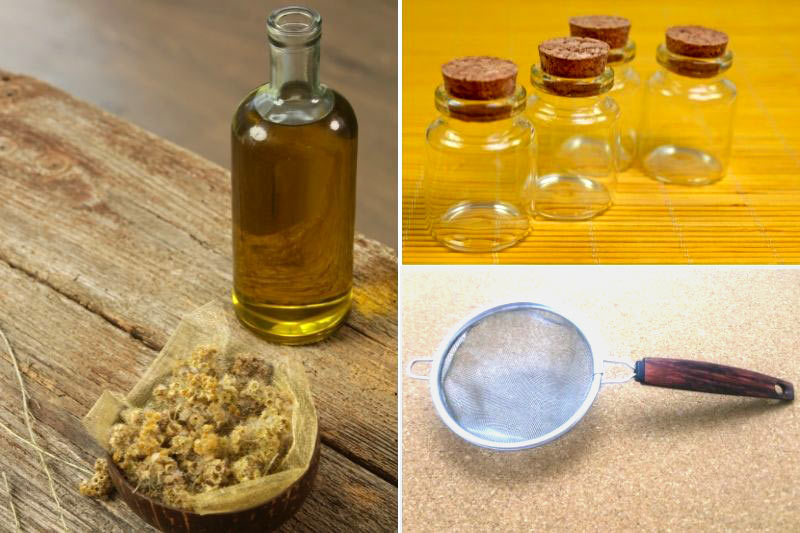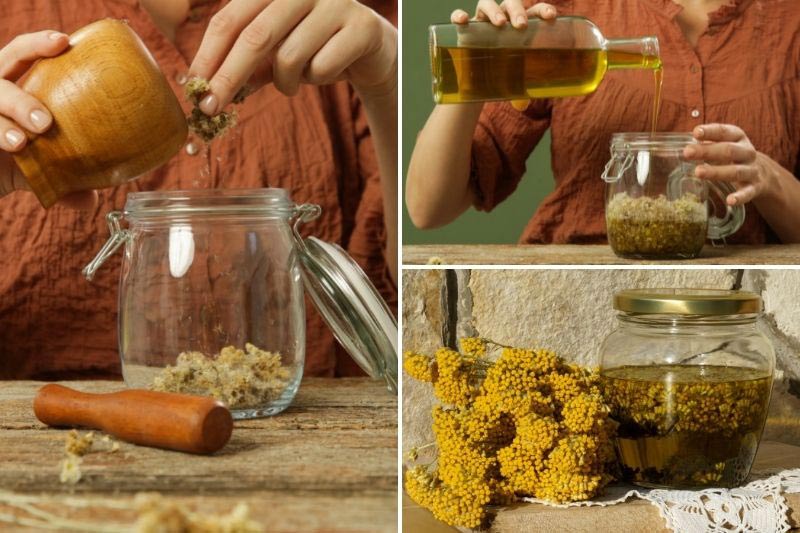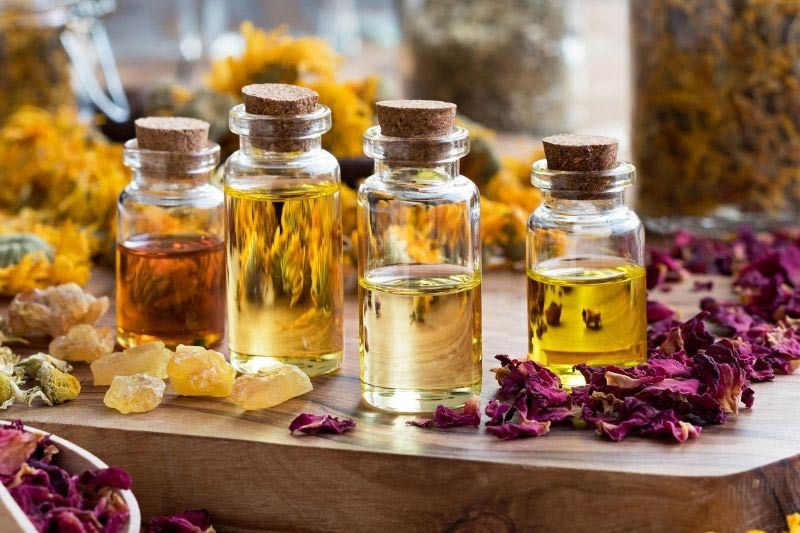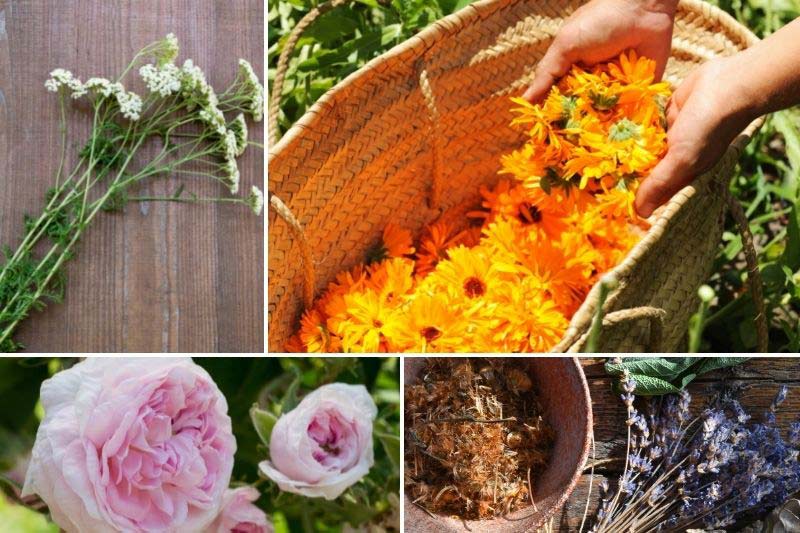A beautiful garden planted with medicinal plants is already very pretty. But even better, is being able to enjoy it by making your own little homemade “potions”.
Among preparations easy to make are plant oils. What are they? They are the maceration of a plant in an oil base intended to extract liposoluble plant active compounds. Oil macerates are generally used for cosmetic purposes, for skin and hair, but also in cooking and care.
This extraction technique of active compounds, although it requires a little time and planning, is very easy to carry out.
What you need to make a plant-based oil
You probably already have all necessary equipment in your kitchen:
- A glass jar with lid, sterilised beforehand and thoroughly dry
Then for filtration:
- A very fine mesh strainer
- An additional container, sterilised as well.
For ingredients, you will simply need:
- A dried plant of your choice. It can be a whole plant, or part of it (depending on which part concentrates most active compounds). It is also possible to macerate a mixture of plants. Quantity should be adapted to chosen container.
- A vegetable oil, preferably virgin cold-pressed and organic.
And that’s all!

Le matériel nécessaire pour faire des huiles de plantes est simple
Now on to the actual making.
How to make an oil macerate?
Choose plant or plant mixture you want to use to make your oil. Be careful, plant must be dry to avoid any risk of fermentation during maceration. If not dry, you will first need to dry it, which usually takes a few days.
-
1st step, maceration
Fill completely, but without packing, clean dry jar with plant or plant mixture of your choice, up to 1–2 cm from rim. Do not skimp on plant quantity; this will give good concentration of active compounds.
Cover with vegetable oil, making sure no plant pieces remain exposed to air. You can tap the side of jar lightly to release any air bubbles trapped at bottom.
Close jar and let preparation macerate for several weeks, usually 4–6, at room temperature. Sun exposure is recommended for some plants, such as St John’s wort. For most other plants, keep preparation out of direct sunlight.
During maceration phase, you can shake jar regularly to mix preparation well.
-
2nd step, filtration
After several weeks, your oil will have become more or less coloured depending on plant used. Then all that remains is to filter. But before that, remember to sterilise jar intended to receive oil, so it keeps well.
For filtration, pour maceration into a fine strainer to remove all plant pieces. If you do not have one, you can use a coffee filter, a muslin, or even a stocking.
Do press well to recover maximum oil.
Then close jar and store out of light and heat. Under these conditions, preparation can keep for several months, up to 6 months.
 Les étapes de la réalisation des huiles de plantesWhich oil to choose?
Les étapes de la réalisation des huiles de plantesWhich oil to choose?
For an oil macerate, choose preferably a stable oil, i.e. one not very prone to rancidity over time and with a fairly neutral scent.
The most frequently used oil in this type of preparation is sunflower oil.
But other oils can work well:
- Grape seed oil is very interesting because, besides its discreet scent, it would also have antioxidant properties.
- Olive oil has a slightly stronger scent, but perfectly acceptable.
- Sweet almond oil, although more expensive, would be particularly suitable for delicate skin.
Many oils can be used, so explore properties of each depending on what you are looking for.
For hair care, olive, sweet almond or grape seed oils are generally preferred.
 Différentes huiles peuvent être utilisées pour faire un macérat huileux
Différentes huiles peuvent être utilisées pour faire un macérat huileux
How to tell if an oil is still good?
Rancidity is main problem that can occur. So when using plant oil, smell it first to make sure it is still good. It is also possible to add vitamin E to extend shelf life.
Which plants?
An oil macerate can be made from leaves, flowers or even roots, depending on which active compounds one wishes to extract.
Here are some easy ones to make.
- Calendula oil made from marigold flowers is reputed to be healing and soothing for irritations.
- Yarrow (Achillea millefolium) would also be healing. Flowers are used.
- Plantain leaves have strong reputation for soothing itching, notably nettle stings.
- Old garden rose, Rosa gallica, is ally of so-called mature skin. Besides scent, flowers would help prevent wrinkles and skin ageing.
- For carrot, root is used. Rich in carotin, it is often recommended for skin care.
- An oil from Roman chamomile flowers could calm irritations and reduce rosacea.
- Arnica, finally, is well known for contusions, bumps and bruises.
 Fleurs d'Achillée millefeuille, de Calendula, de Rosa galica, Arnica et Lavande
Fleurs d'Achillée millefeuille, de Calendula, de Rosa galica, Arnica et Lavande
If these oils are already interesting on their own, you can also make blends. For example, an oil of rosemary and thyme leaves together with lavender flowers could encourage hair growth.
In short, possibilities are numerous. Give it a go!































![How to Make Plant Oils [recipe name="Macérât huileux" ingredients="dried flowers or herbs, vegetable oil" time="4-6 weeks" difficulty="easy"]](https://en.promessedefleurs.eu/blogwp/wp-content/uploads/2022/05/1-1.jpg)
Comments